Knowlton Science Center
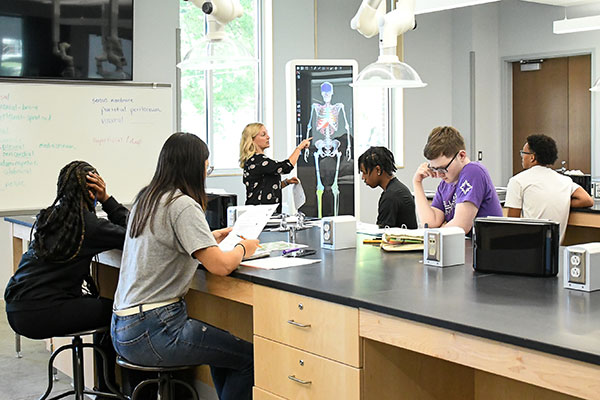
The journey to Bluffton’s third science building since 1914 started in 2012, just as the Sommer Center building project was finishing up. At that time, it was the Board of Trustees who asked with great enthusiasm, “What’s next?” The answer was the $26 million Simply Innovate Campaign. The campaign moved Bluffton into the future and granted students access to a new science facility, the latest technology and the means to explore deeper. With our committed teaching faculty – and now this building to sharpen our program delivery – Bluffton students are provided with a truly outstanding education in the natural and applied sciences as they prepare for advanced study, careers and service to others.
The facility was dedicated on Oct. 21, 2023, during the President’s Society Banquet, but opened to students on Sunday, Aug. 27, ahead of the first day of classes.
First-year biology and chemistry double major Logan Daugherty quickly found a homebase on campus in the Knowlton Science Center.
“There’s always a few people studying or just hanging out in the first-floor lobby,” said Daugherty, of Bradford, Ohio. “It’s so nice. There’s a big desk with outlets to charge your things, and there’s a big white board you can use to study.”
Addie Hilden ’26, a biology major from Lima, Ohio, and Miranda Sorg, a biology major from Wellington, Ohio, agreed. They both appreciate the big windows and natural light.
“It’s a good environment,” said Hilden. “It’s really cozy and it’s great for studying.”
“After we finish our classes, we go to dinner and then we’re over there studying every night,” added Sorg.
Many alumni explored the nearly 20,000 square foot building and its six labs during a Homecoming open house. 2022 graduate Ben Heck noted the Anamotage Table, which is similar to the ones used at the University of Toledo College of Medicine and Life Science where he is now studying, and the chemistry hoods.
“It’s super cool,” said Heck of Alvarada, Ohio. “You you can fit more people in the lab and students will be able to hear and see everything on the monitors.”
Larry ’67 and Loiuse (Shank ’68) Reeser, of Heyworth, Ill., spent time in the Wannemacher Food Science Lab. A home economics major, Louise learned more about the new Master of Nutrition and Dietetics program.
“It’s very beautiful and a good recruitment tool,” said Reeser. “I think it’s going to be appealing to students to stay and get their master’s.”
Lauren (Selleck ’03) Gajdek, of Seville, Ohio, came back to campus for the first time in 20 years. Her daughters drew a scientist on the white board in Dr. Angela Montel’s biology lab while they learned more about the facility.
“It took me a few minutes to get my bearings of campus because it’s been so long and there are changes,” said Gajdek, “but it’s really nice.”
For now, physics and engineering labs will continue to be held in Shoker Science Center.
Biology
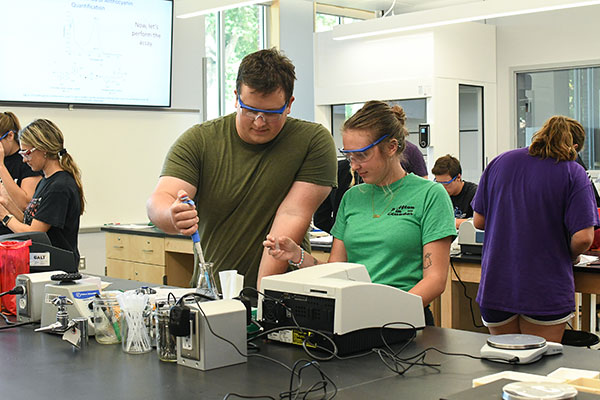
“It’s exciting to have people walk by and see science happening,” said Dr. Angela Montel, professor of biology, of the large interior windows cut into each lab. “We were kind of hidden down in Shoker. Now, we can feel the warmth of the lobby and see students working with the light right behind them.”
The building also includes features such as accessible work benches for students in wheelchairs, refrigeration, sinks with hot water access and an ice machine.
Biology specifically has new incubators, microscopes and dissecting scopes with detachable cameras for viewing on large monitors. In the spring, a large autoclave is being installed for sterilizing equipment and destroying spent media such as batches of bacteria.
Dr. Sarah Lehman, assistant professor of biology, is also making use of a new Anamotage Table to teach students about the body and its systems.
“There’s just so much more we can do,” said Lehman. “And I’m excited about the cross-disciplinary ways we can use this space outside of our department.”
Nutrition and dietetics
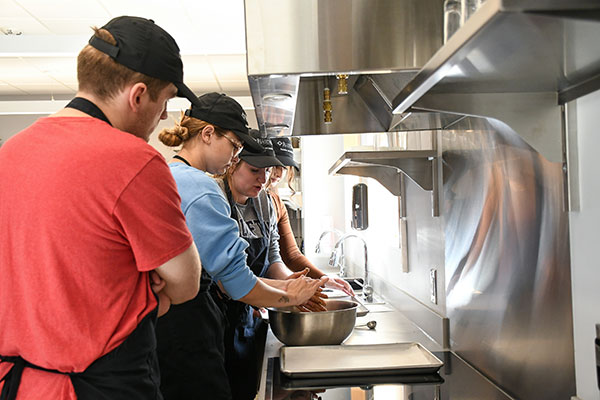
Nutrition and dietetics students are gaining hands-on experience in a commercial kitchen facility featuring a double deck convection oven, commercial refrigerator and stainless-steel tables.
“I did a lot of research to find the best equipment that will last us a long time,” said Dr. Deb Myers, professor of food and nutrition. “Students are really enjoying the new facilities.”
Myers is currently using the lab in her Commercial Foods class, and students recently made 40 dozen cookies which were donated to a soup kitchen in Lima, Ohio.
Abby Stemen, assistant professor of food and nutrition, is excited for community members to experience the food demonstration setup, featuring an overhead camera and monitors, during Lunch and Learn events.
“We’ve never had a proper demonstration space, so it is a much better setup for that purpose,” said Stemen. “It will also be a great space for the new Cultural and Consumer Foods Course. I foresee us using this space in a lot of different ways.”
Chemistry
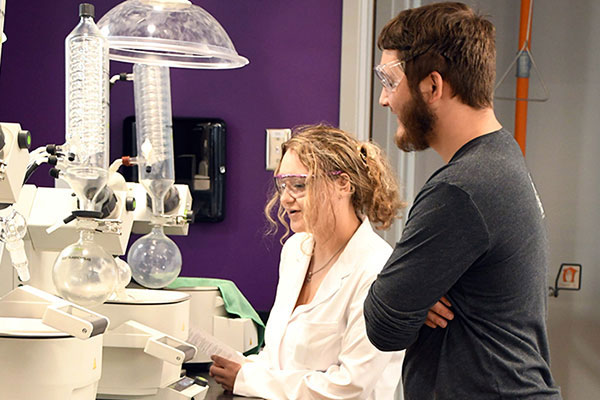
For Dr. Daniel Berger, professor of chemistry, science is science no matter the location where it’s being taught. However, the new facility has advantages such as exhaust hoods and new equipment.
Next semester, Berger will make use of a new Nuclear Magnetic Residence spectrometer with a higher resolution. The updated NMR will allow students to discern more subtle data.
“It’s not the highest resolution possible but it’s the highest without getting into some very expensive cryogenics and just using a regular room temperature magnet,” said Berger.
Plus, the building offers plenty of collaborative spaces and study nooks.
“I think the students are enjoying the new building. I’m seeing them in here studying and even non-science majors are in here using the space,” said Berger. “I have one student from my general education class that consistently shows up to study in one corner of the building.”
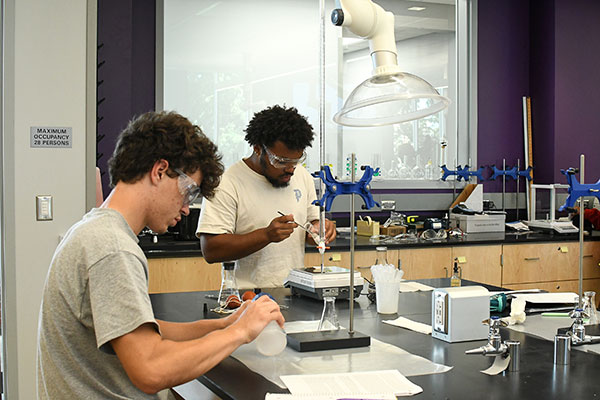
Dr. Charles Daws, professor of chemistry, is making use of two lab spaces including an analytical lab space with equipment that won’t need to be torn down and reset for general chemistry classes.
“Two or three different labs can be run in that one so if we have free time we can do research in it,” said Daws. “That’s a possibility we didn’t have in Shoker.”
His new equipment includes centrifuges and, like the other spaces, large monitors that can display PowerPoint presentations and information straight from his laptop.
He lifted up the number of Bluffton graduates who go on to graduate school and medical school.
“I think all of our science faculty are challenging the students to be the best they can be. To be successful,” he explained. “We try to get students to think through a problem and the different ways to solve or approach the problem. It’s not just about chemistry. They can apply these problem-solving skills hopefully in life.”